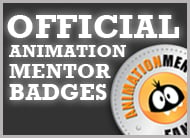
That's a hard one to answer. It may be easier if I start with my LEAST favorite part(s) of the process.
I really don't enjoy research and planning. This is a shame because generally I find that I do better work when I have researched and planned exhaustively. I find the process tedious, though, and I'd
much rather jump in and start animating! I liken it to broccoli: I
don't really enjoy the taste, but I know it's good for me and I'll be
glad I ate it when the meal is over. I'm sure you know the feeling.
Once my planning is done, I really enjoy blocking. Depending on what kind of scene and characters I'm working with, I block in different ways. If I'm doing an acting shot with humanoid characters, I'll probably block pose-to-pose with stepped keys. I like designing the poses and finding the best silhouette, as well as flipping between the poses to see how they flow together. I'm not worried about timing yet, just the sequence of ideas. I'm trying to hit the poses in my video reference or sketches with the 3D model, and adjusting as necessary to match the style of the film and the physiology of the character. If I'm going off video reference, then I'm probably pushing the poses further and simplifying them. If I'm going off of sketches, then I'm probably trying to push the 3D model to match the dynamic of the loose sketch. If I'm blocking in a layered fashion, such as with cars, fish, or robots, then I'm dropping keys on my root rotates and translates and pushing them around in the spline editor to find the timing and rhythm of the shot. Ideally I'm getting real-time playback from my models, and I enjoy fine-tuning the timing and arc patterns to suggest the attitudes and actions.
The other part of the animation process I don't really like is the transition from blocking with stepped poses into splines. Suddenly all my snappy timing looks like crap, and it almost feels like I'm starting over again. It takes so long to get the animation tied down to where the timing is right again. Luckily this doesn't last too long, and I have a pretty routine series of adjustments I can perform on the splines to get the shot in better shape. Mostly it involves adding more ease-in's to my holds, pushing my keys around to tighten or loosen timing, and adding in a few more breakdowns as needed. I don't start offsetting keys in time until later in my process, and I keep all my controls keyed on every pose.
After I've done my first pass on the splines, that's where the fun begins for me. I can put on some music and start massaging all my actions. I focus sweetening the timing by adding contrast, simplifying actions that are too complicated, adding little details that weren't in the blocking, and sculpting my arcs and spacing. This can be a very technical and procedural process, but I find it puts me in kind of a zen state, and the time just flies by.
Once I get to the final polish stage, I start to enjoy the process less again. Maybe it's because I'm getting tired of the shot and can't see it objectively anymore. Maybe it's because I'm ready to move on. Or maybe I just don't feel like overlapping any more pinkies! It's not such a problem on short shots, but lately on
Toy Story 3 I've been getting whoppers – full-body human acting shots of 300 frames or more. These can really test my stamina, but I've enjoyed the challenge and can't wait to see them lit and rendered!
Guest Blogger
Victor Navone






We're Social!